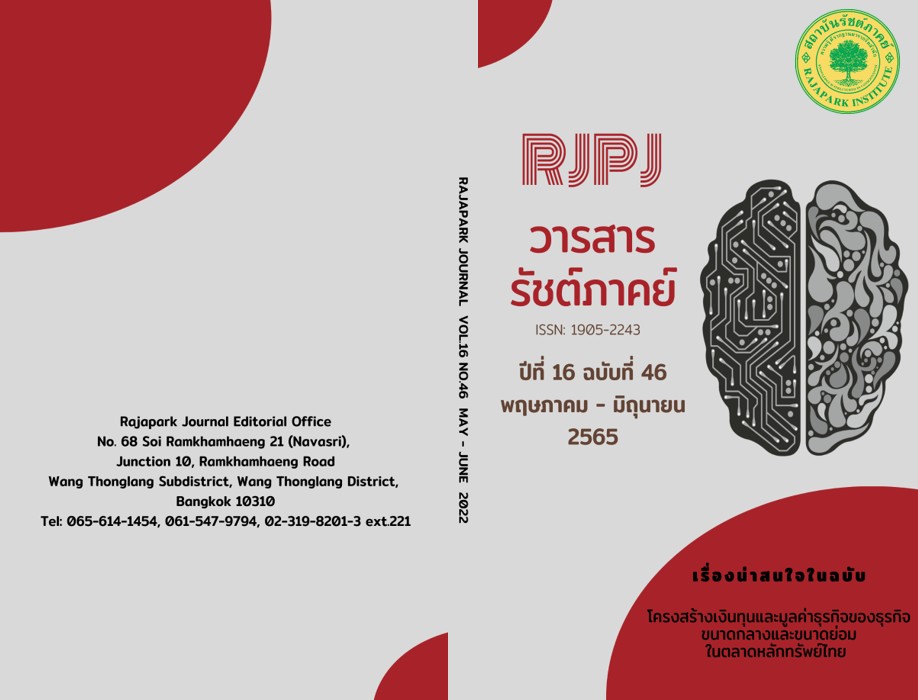Situations, Needs and Guidelines for the Development of School Learning Organization Under the Office of Mukdahan Primary Educational Service Area
Main Article Content
Abstract
This research aimed to study 1. The current state and the desirable state of being a school's learning organization. 2. Assess the needs and requirements for the development of the school's learning organization. 3. Develop guidelines for the development of a school learning organization Under the Office of Mukdahan Primary Educational Service Area by research Research & Development (R&D). The sample group used in the study were school administrators and teachers, totaling 469 people. The sample size was determined by comparing the tables of Krejcie and Morgan by stratified random sampling. There are 4 data collection tools which are: (1) Current Condition Questionnaire, (2) Desirable Condition Questionnaire, (3) Structured Interview Form, and (4) assessment form for the appropriateness and feasibility of the guidelines for developing the operation of being a learning organization of the school. The statistics used were percentage, mean, standard deviation, and modified priority needs index (PNImodified). The research results were found as follows; 1) current and desirable conditions Overall, it was at a high level. 2) Necessary needs. found that the higher side the total value, in descending order, was the aspect of team-based learning. systematic thinking in terms of having a shared vision and 3) the results of the assessment of the school's development as a learning organization as a whole, it was found that the overall suitability was at the highest level and was feasible. Overall, it's at a high level.
Article Details

This work is licensed under a Creative Commons Attribution-NonCommercial-NoDerivatives 4.0 International License.
Views and opinions appearing in the Journal it is the responsibility of the author of the article, and does not constitute the view and responsibility of the editorial team.
References
Chaowanasiritham, S. (2017). The Development of a Learning Organization of Urban Community College of Bangkok. Modern Management Journal, 15(2), 57-66.
Cumming, T. G., & Worley, C. G. (2009). Organization Development & Change. South-Western Cengage Learning.
Daft. (1998). Essentials of Organization Theory and Design Cincinati. South-Western College.
Garvin, D. A. (1993, July-August). Building a Learning Organization. Harvard Business Review. https://hbr.org/1993/07/building-a-learning-organization
Gephart, M. A., Marsick, V. J., Van Buren, M. E., Spiro, M. S., & Senge, P. (1996). Learning Organizations Come Alive. Training & Development, 50(12), 34-45. https://eric.ed.gov/?id=EJ535275
Intachai, M. (2017). Guidelines for the Development of Learning Organization of Anubanphayao School Primary Educational Service Area Office Phayao 1[Independent Study, Chiang Rai Rajabhat University].
Kankaew, K., Chareonnit, K., Woramontri, R., Kangwon, K., & Komolwanij, T. (2020). Learning Organization: The Challenges of Knowledge Management in the Changing Paradigm. Journal of Legal Entity Management and Local Innovation, 6(2), 241-254.
Khamphula, M., & Amatariyakul, W. (2021). The Guidelines for Learning Organization Development of School under the Office of Primary Education Service Nongbualamphu Province. Journal of MCU Nakhondhat, 8(2), 355-367.
Khunmin, N. (2015). A Study of Conditions and Guidelines for the Development of Learning Organizations of Educational Institutions under the Office of Kamphaeng Phet Primary Education Area 1[Master’s Thesis, Phibunsongkhram Rajabhat University].
Khejaranan, N. (2008). TQM: Strategy for Building a Quality Organization. Tankamon.
Krejcie, R. V., & Morgan, D. W. (1970). Determining Sample Size for Research Activities. Educational and Psychological Measurement, 30(3), 607-610.
Marquardt, M. J. (1996). Building the Learning Organization. McGraw-Hill.
Nuibandan, P. (2010). Learning Organization. Journal of Nursing Education, 10(3), 13-17.
Panich, V. (2012). Ways to Create Learning for Students in the 21st Century. Sodsri-Saritwong Foundation.
Pedler, M., Burgoyne, J., & Boydell, T. (1998). The Learning Company: A Strategy for Sustainable Development (2nd ed.). McGraw-Hill.
Phothong, A. (2016). School Administrators and Teachers Behavior under the Secondary Educational Service Area Office 5 of the School Development to be Learning Organization. In Proceedings of the 13th KU-KPS Conference (pp. 2355-2367). Nakhon Pathom, Thailand.
Plianbumroong, D., Passornsiri, N., Phuangsomjit, C., & Wannasian, D. (2012). Strategies for Development of Learning Organization for Nursing Colleges under Phra Borommarajchanok Institute, Ministry of Public Health. KKU Research Journal, 2(1), 94-114.
Putprapha, R. (2017). Learning Organization of Ban Lan Laem School (Saranuwat Ratuthit)[Master’s Thesis, Silpakorn University].
Rattanadilok Na Phuket, P. (2009). Organization and Management. Think Beyond Book.
Runcharoen, T. (2007). Professionalism in the Organization and Administration of Education in the Educational Reform Era (4th ed.). Khao Fang.
Saenthaweesuk, P. (2010). Guidelines for Developing Educational Institutions to Become a Learning Organization of Educational Institutions under the Ubon Ratchathani Provincial Administrative Organization[Master’s Thesis, Ubon Ratchathani Rajabhat University].
Senge, P. M. (2006). The Fifth Discipline: The Art & Practice of the Learning Organization (Revised & Updated ed.). Doubleday.
Somthob, W. (2015). Guidelines for Developing Organization of Learning in Basic Education Institutions. Under the Office of Kanchanaburi Primary Educational Service Area District 1[Master’s Thesis, Kanchanaburi Rajabhat University].
Sornchamni, C. (2011). Strategic Planning and Service Quality Development of Nonthaburi Hospital. Sukhothai Thammathirat Open University.
Traicharoenkulphak, W. (2015). All about Learning Organization (LO). Long Life Ed.
Ubben, G. C., Hughes, L. W., & Norris, C. J. (2001). The Principal: Creative Leadership for Effective Schools. Allyn and Bacon.
Wongwanich, S. (2015). Research to Assess the Need for Necessity. Faculty of Education, Chulalongkorn University.


